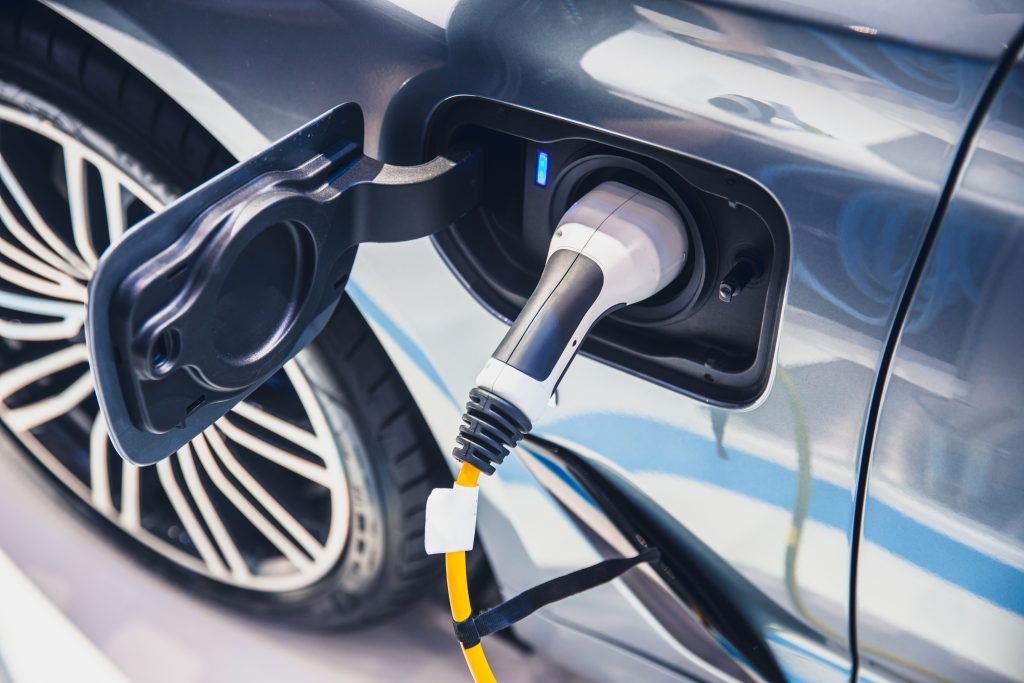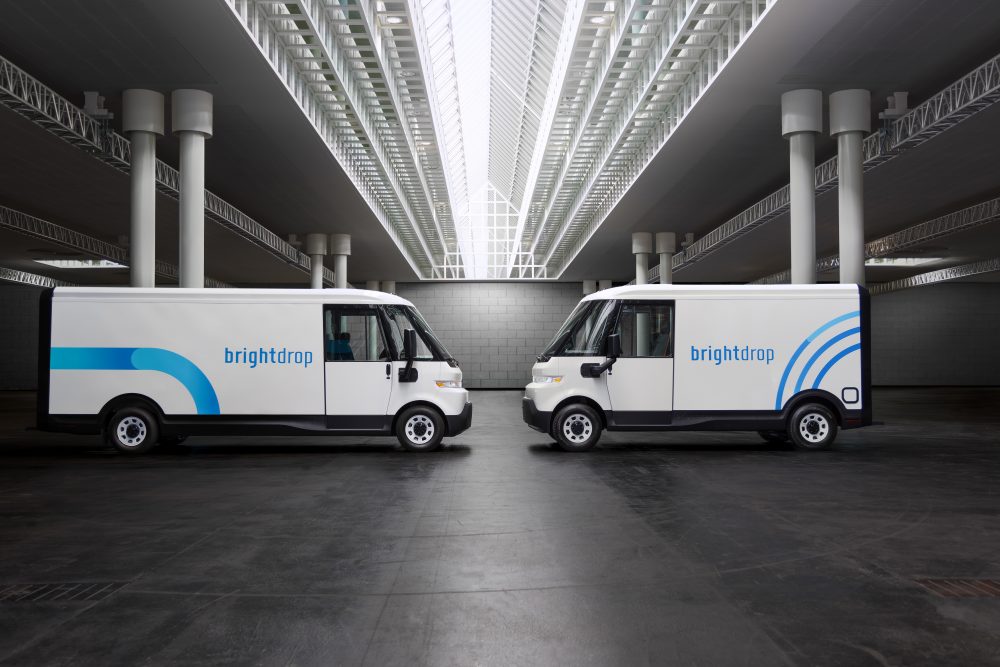The changing face of transportation continues to have ripple effects throughout retail. From charging stations in parking lots to battery-powered delivery trucks and last-mile eMobility solutions, electricity is the one mobility trend you can count on seeing more of this fall.
From the retro Volkswagen ID.Buzz microbus to the RAM 1500 REV pickup truck, electric vehicles (EVs) continue to be announced with ranges of up to 500 miles, while the federal government’s infrastructure bill is spurring the buildout of more charging stations. Meanwhile, commercial electric trucks are already sold out for the rest of the year, with companies from Walmart to UPS planning to expand their EV fleets. And eBikes, which gained in popularity during the pandemic, have become established as part of the delivery chain, including cargo eBikes for last-mile deliveries. And what of the self-driving car future that we were promised? Robot deliveries have been scaled back, but GM says autonomous vehicles are still coming—just a little more slowly than originally thought.
The EVs Are Coming
The most significant trend in transportation continues to be the explosive sales of EVs. According to research firm Cox Automotive, sales of EVs in the U.S. were up 45 percent for the first quarter of 2023 when compared to last year. Total EV sales for the period amounted to 259,000 vehicles, with total sales of electrics expected to top 1 million vehicles in the U.S. for the first time ever in 2023.

That translates into increased demand for public charging stations. The bipartisan $1.2 trillion infrastructure bill, signed into law in 2021, included $7.5 billion to build out a nationwide EV charging network, including help reaching rural areas. But as Brendan Jones, president of Blink Charging, reminded Dealerscope last year, “getting approval from local and state governments takes time.”
The continued slow expansion of a national charging network means opportunities for retailers, according to Jones. By teaming up with companies such as Blink, customer parking spaces can be converted into charging bays, delivering what are essentially captive buyers. Even fast charging stations take about 30 minutes to refuel a typical EV. That is 30 minutes customers could be shopping in nearby stores.
Retailers who’ve made the move to modify some spaces for EV owners usually choose a revenue sharing model where the network operator is responsible for setting up and managing the charging stations. Since charging capabilities are continuing to evolve, that’s a prudent choice, especially considering that Ford recently made an announcement that threatens to upend the accepted charging standard in the U.S.
All EV manufacturers in the U.S. — except one—use a common plug-in connector and protocol for charging called J1772. The outlier, of course, is Tesla, which has its own proprietary plug-and-charging network. Until recently, that has meant that Tesla vehicles could only charge at Tesla-branded stations, and other EVs could not use the Tesla stations — unless you used an adapter, however, adapters can cost up to $200 and often don’t work with other EV’s software.
Under government pressure to make its charging network more accessible, Tesla has promised to make some of its high-speed chargers available to other EVs in the future. And now Ford has announced that beginning in 2024 it will offer its EV owners an adapter and update its vehicle software to work with Tesla’s network of stations. However, what has caused a fair amount of confusion in the EV market is that Ford also said that, as of 2025, all the built-in EVs will have built-in support for Tesla’s unique plug.
Many analysts and potential EV buyers are now asking if it means Ford is abandoning the North American charging standard. Will Ford’s 2025 Mustang Mach-E and F-150 Lightning electrics have two different physical charging ports built in—or only a plug for Tesla’s stations moving forward? Questioned on this issue over email, a Ford spokesperson was unable to quell the confusion, stating the company has “no specifics to share right now.”
Whether Ford’s moves discourage consumer interest in EVs or not, interest from commercial operators isn’t likely to wane. Electric trucks require less maintenance and lower operating costs compared to expensive diesel models, and EV truck makers from Amazon-backed Rivian to GM-backed Brightdrop are sold out through the end of the year.
BrightDrop has boasted that Ryder plans to add 4,000 BrightDrop Zevo 600 and Zevo 400 electric vans to its lease and rental fleet through 2025. Meanwhile, FedEx has said it plans to buy only electric vans by 2030, with its entire fleet going all electric by 2040. And the U.S. Postal Service has ordered over 9,000 all-electric E-Transit vans from Ford that should be in service by the end of next year.
With more and more EV delivery truck options becoming available, all this is good news for retailers looking to make the switch.
eBikes Go Big
While cities are still grappling with the proliferation of electric bikes, eBikes continue to offer a fast and efficient method of delivery for many businesses. Able to circumvent traffic congestion and take advantage of the increasing number of dedicated bike lanes, cargo eBikes can make 10 deliveries per hour in cities compared to delivery vans that were only able to fulfill six orders in the same amount of time, according to a 2021 U.K. study. That makes cargo eBikes ideal for traversing the last mile between retailers and customers, and it is why an estimated 80 percent of delivery workers rely on eBikes and Vespa-like scooters, according to the Workers Justice Project, an advocacy group.
“Cargo bikes are perfect for making deliveries in cities,” says Eric Asmussen, the managing director in North America for Cake. Founded in Sweden, Cake makes a line of cargo and consumer eBikes as well as electric motorbikes, all designed to withstand the punishing streets of urban environments.

Asmussen emphasizes that companies switching to eBikes help reduce traffic, pollution, and improve customer service. He points out that cargo bikes can also be used in larger retailers’ hub-and-spoke delivery systems, so that large trucks don’t have to enter city cores. That is likely to be an issue in the future as cities such as New York adopt congestion pricing models and charge trucks additional tolls. It is another reason the electric cargo bike market is expected to grow annually in the U.S. by 9.5 percent, according to researchers at Future Market Insights.
Increasingly, cargo bikes are also being outfitted with sophisticated accessories, such as heated—and chilled—delivery boxes. Dometic, which has a long product history of making refrigerators and related products for outdoor, RV, and maritime uses, now offers delivery boxes for cargo bikes that keep food hot and cold in the same container.
Dometic has already completed one pilot program in the U.S., and “we’re currently in conversation with several national restaurant chains, which is very exciting,” said Andreas Karlsson, president of Dometic Residential in the U.S.
Such options give retailers even more delivery choices while addressing one of the main grievances from consumers: 37 percent of complaints are because food arrived cold, according to Karlsson.
An Autonomous Future?
Robots continue to be tested for last-mile deliveries, as well. Serve Robotics, which was spun out of Uber, is testing autonomous delivery R2-D2-style robots in West Hollywood, with plans to expand the test into other communities with as many as 2,000 self-driving sidewalk drones.
However, so far, such robot delivery services have worked best in controlled environments, such as airports and corporate campuses. Starship Technologies, for example, has over 30 delivery bots operating on the UNC Charlotte campus that students can use via an app. At the Luma Hotel in New York’s Times Square, Relay Robotics models are in operation handling basic room service requests.
But what about the autonomous car future that was supposed to have arrived by now? It turns out solving the problem of unique or so-called “corner cases” in driving environments has been tougher than engineers and AI advocates predicted. But automakers are still forging ahead with self-driving vehicle research.
In fact, in June at a business conference, General Motors’ CEO Mary Barra said she still saw a giant growth opportunity ahead in the autonomous vehicle market. Except, that future is still years away with personal self-driving cars not expected to hit the market until the end of the decade.















